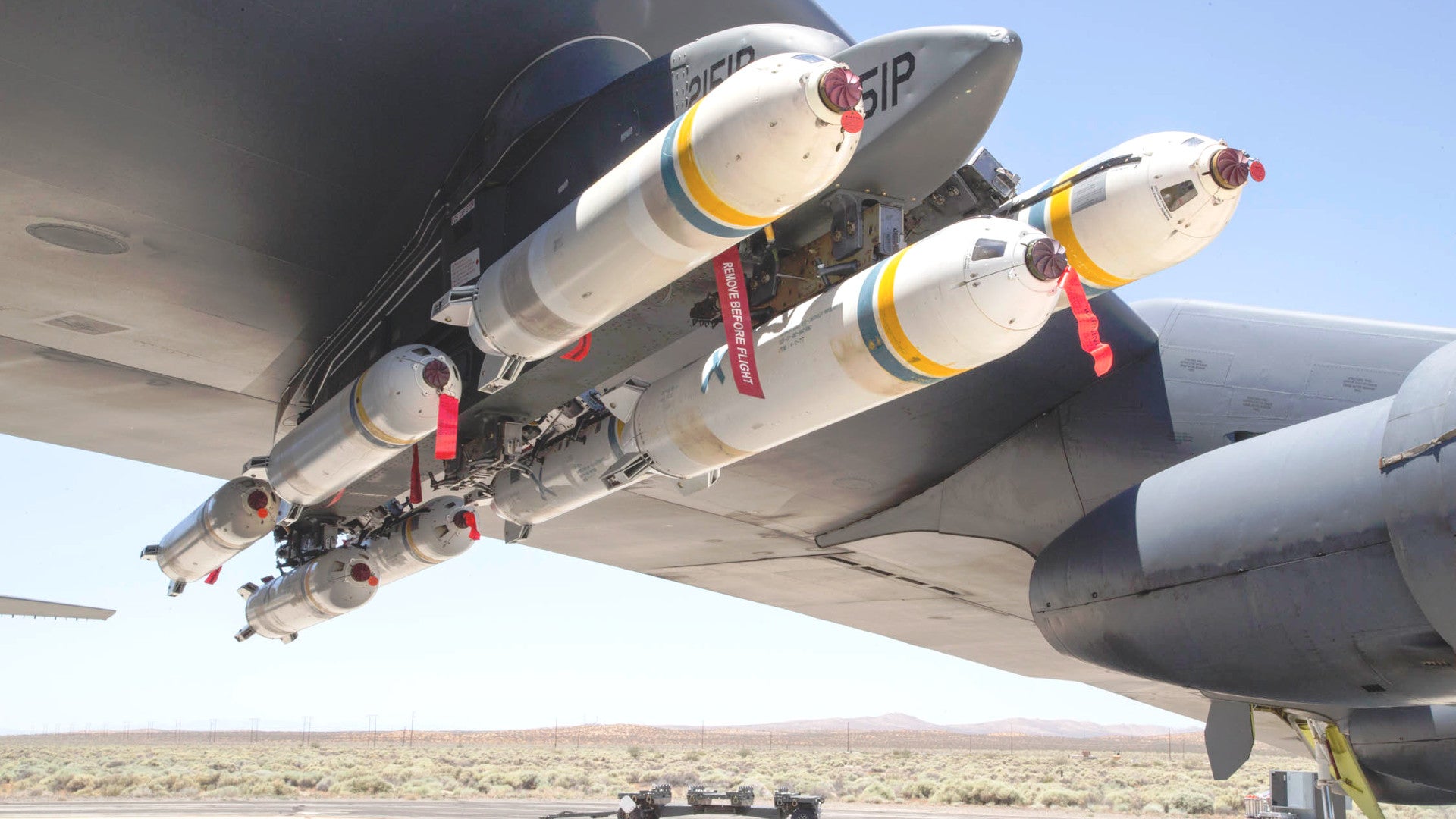After more than half century of service, the U.S. Air Force’s B-52 bombers remain an iconic symbol of America’s military power, able to carry some of the most destructive weapons in existence. Now the service is looking to expand the plane’s arsenal even more in order to help it perform one of its less well known missions, psychological warfare.
On July 25, 2017, the Air Force announced that a B-52H bomber from the 419th Flight Test Squadron had finished a series of test drops of the PDU-5/B. Though it might look like a cluster bomb at first glance, this dispenser actually holds tens of thousands of paper leaflets that, in an operational environment, might implore the enemy to abandon their cause or tell civilians to avoid certain areas.
The PDU-5/B uses the same dispenser, called the SUU-76, as the CBU-100/B Rockeye II anti-tank cluster bomb. It functions the same way, too, with a fuze in the nose causing the canister’s shell to split open, releasing the payload inside. The easiest way to tell the two apart is by the PDU-5’s blue stripes, indicating an inert device.
“We are primarily looking to see safe separation from the external Heavy Stores Adapter Beam,” Kevin Thorn, the B-52 air vehicle manager for the 419th, told the service’s reporters. “We are ensuring that the bombs do not contact the aircraft, and/or each other, creating an unsafe condition.”

Each B-52 has a pair of “Heavy Stores Adapter Beams,” one under each wing, each of which can hold up to nine approved munitions, depending on their size and weight. During the tests, the Stratofortress only carried eight dispensers on the racks, leaving the center six-o’clock position empty. The actual test drops occurred over the Point Mugu Sea Test Range off the coast of California and on land at the Precision Impact Range Area at Edwards Air Force Base.
The tests were reportedly successful, but there is no indication when B-52s might use the PDU-5s in an actual war zone. Earl Johnson, in charge of the program to integrate the bombs onto the BUFFs, said the next step would be making sure they functioned properly when the aircraft released them from its internal bomb bay.
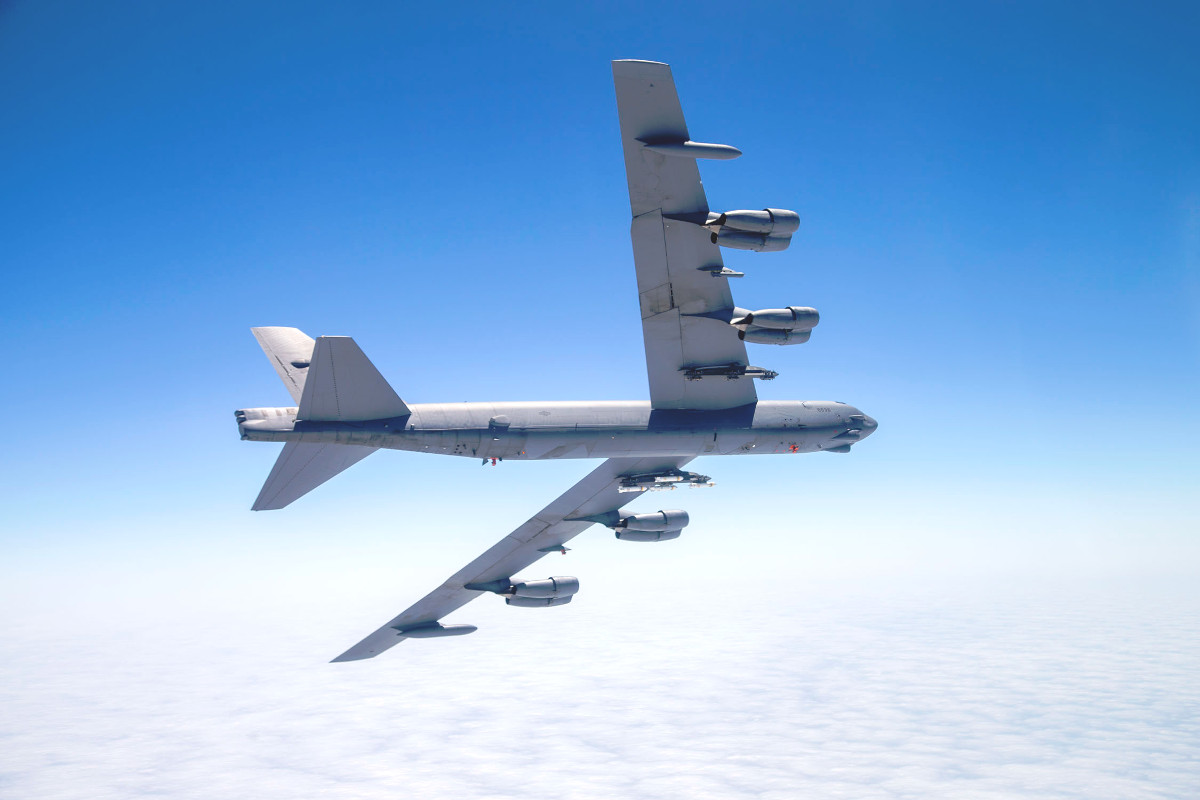
It is possible the Air Force may want to get that testing done sooner rather than later so they can get loads of PDU-5s out to B-52s flying over Iraq and Syria. “Without the capability to carry PDU-5s on the B-52 aircraft, the impending shortfall on leaflet dispersal capability will jeopardize Air Force Central Command information operations,” Johnson explained.
Despite being a very low-tech concept, leaflet drops are also relatively low cost and have been a regular component of coalition air operations against ISIS. Many of the leaflets warn civilians of impending strikes, telling them to flee to safety – something that unfortunately isn’t always an option, even if people are willing to abandon their homes in the first place. There’s always the problem of whether the target population will even be able to read them, too
American aircraft notably dropped some of the paper notes ahead of a spectacular attack on trucks carrying ISIS oil near Abu Kamal, Iraq in November 2015. A-10 Warthogs and AC-130 gunships pummeled the site, destroying more than a hundred tankers.
“We assessed that these trucks, while although they are being used for operations that support ISIL, the truck drivers, themselves, probably not members of ISIL,” U.S. Army Col. Steve Warren, then the top spokesman for the American task force leading the fight against ISIS, told reporters on Nov. 18, 2015, using another common acronym for the terrorist group. “They’re probably just civilians.”
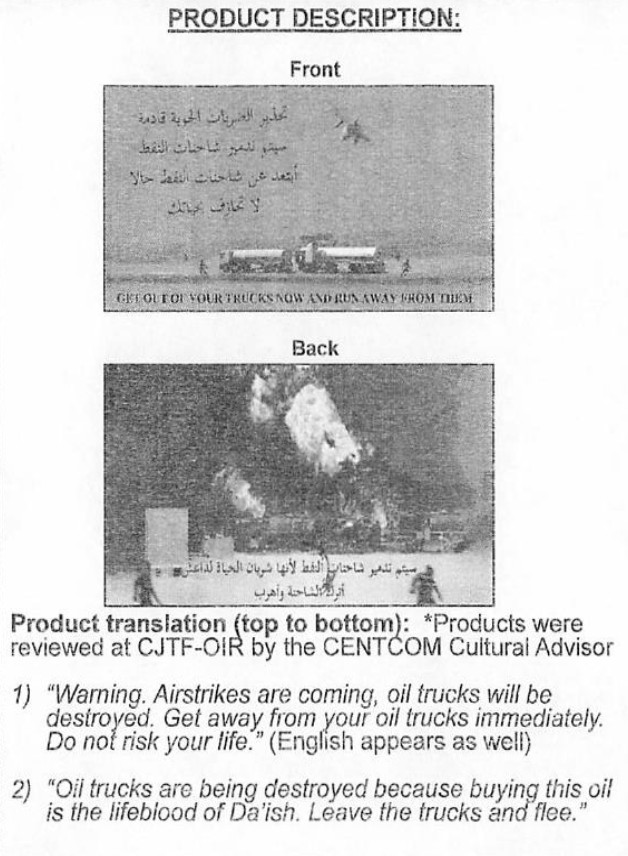
Not looking to deliberately kill innocent bystanders caught up in the conflict, American commanders chose to send them a literal message. The leaflets, copies of which I later obtained through the Freedom of Information Act, told them to get away quick.
“Airstrikes are coming, oil trucks will be destroyed. Get away from your oil trucks immediately. Do not risk your life,” one side said. “Oil trucks are being destroyed because buying this oil is the lifeblood of Da’ish. Leave the trucks and flee,” the other side added, using another term for ISIS.
Ahead of similar strikes against hundreds more tankers and other oil infrastructure in neighboring Syria, U.S. aircraft dropped more leaflets with similar messages. “The Coalition Forces will continue to attack all Da’ish controlled oil facilities until Da’ish is defeated,” one declared.
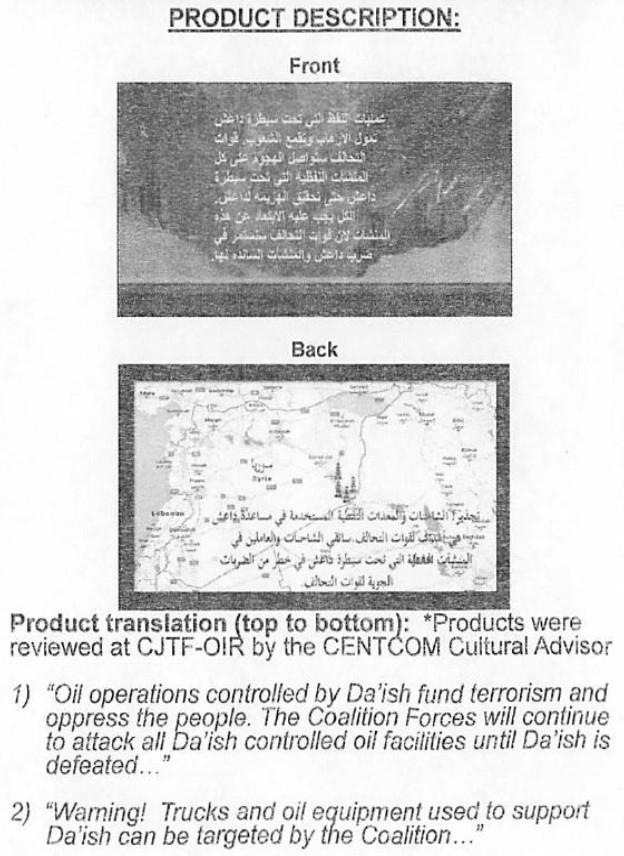
Separately in 2015, American forces dropped much more graphic missives in Syria, according to a report by The Washington Post. One showed terrorists feeding young men into a meat grinder, an allegory ISIS’ leadership blindly throwing them to their death in a hopeless struggle against the United States and its allies.
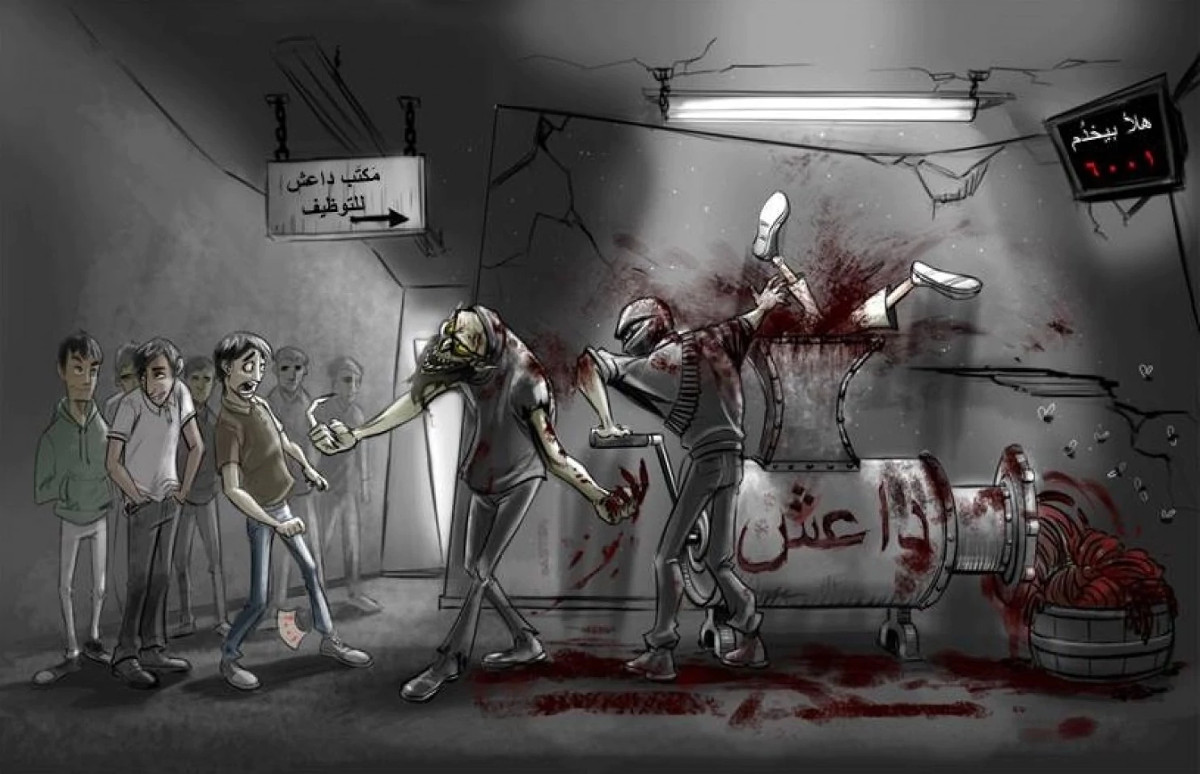
We don’t know what aircraft actually dropped the leaflets in these instances, or whether they used PDU-5s in each case. The U.S. military also has the capability to use helicopters and low-flying cargo aircraft to drop cardboard boxes full of messages in low-risk environments.
According to an official U.S. Central Command regulation covering “Military Information Support Operations,” or MISO, another term for psychological warfare, the Combined Air Operations Center at Al Udeid Air Base in Qatar would process each request for a leaflet drop involving fixed wing aircraft and determine what method would be most appropriate. We obtained a copy of this document via FOIA.
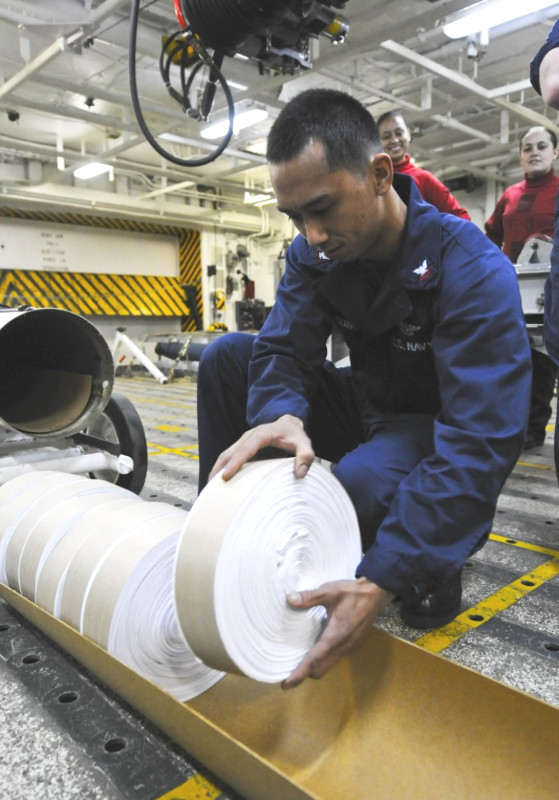
After that, the information would go out to either a U.S. Navy aircraft carrier operating in the region, each of which has the facilities to print and pack leaflets independently, or to the land-based Joint Information Support Task Force (Special Operations), which is part of Special Operations Command Central. The special operations forces personnel would then provide leaflets to Air Force units who would pack them for the final drop over the target area.
Now, B-52 bombers have been flying sorties against the terrorist group from Al Udeid since April 2016. One official video clip, seen below, confirms that the aircraft have been adding to these psychological missions already, but using much older M129E1 or E2 leaflet bombs.

Dating back to the 1960s, these dispensers can only hold 30,000 leaflets each. More importantly, the Cold War-era M129s are long out of production. Originally intended primarily for high performance multi-role fighter aircraft like the F-16, F-15E Strike Eagle, and F/A-18 Hornet, the PDU-5 will eventually become the only leaflet bomb in U.S. inventory.
So it makes perfect sense to add the PDU-5 to the B-52’s arsenal in order to help ease the burden on those fast flying aircraft and free them up for more strike and close air support missions that require their ability to respond at high speed. Compared to tactical fixed wing aircraft, the BUFFs could carry the weapons to much more distant or remote target areas without the same need for extra fuel, too.
The B-52s can simply lug significantly more payload, overall, as well. A full load of 16 PDU-5s on the wing racks alone would contain nearly a million leaflets, which could cover a wide array or multiple distinct zones in a single flight. With a leaflet bombs in its internal bay and GPS-guided Joint Direct Munitions out on the wings, the lumbering BUFFs might even be able to perform psychological missions and remain on station for actual kinetic attacks all in the same sortie.
So if you see what looks like cluster bombs under the wings of B-52s in the Middle East any time soon, make sure to look for the blue bands first. What you might have is a bomber headed out on a psychological warfare mission with the newest “weapon” in its arsenal.
Contact the author: joe@thedrive.com
